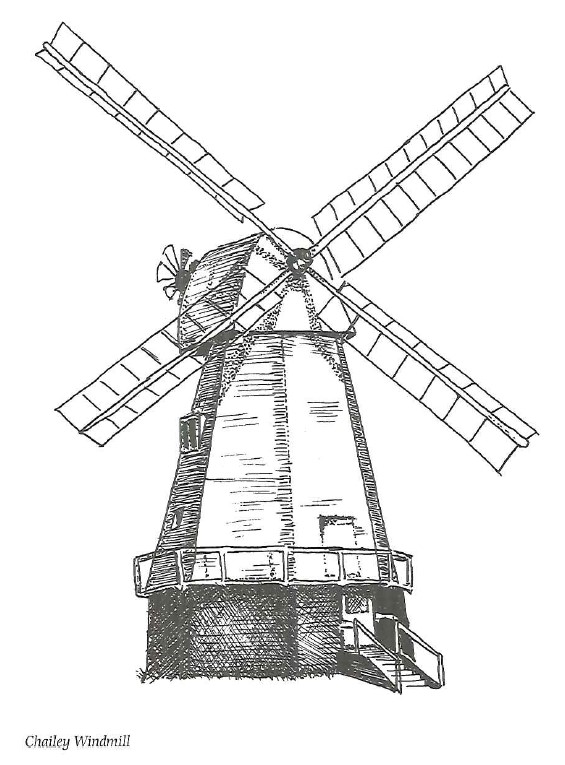The War-bil-in-Tun is the name of the pub. Is it an appalling pun on the name of the village or, as the story goes, a name provided by an historical event? They say an impatient soldier came this way centuries ago and in his greed for beer when he arrived at the ale house chopped open the barrel with his bill or halberd. Get it?
In the tower of the church opposite was imprisoned Richard Woodman, most famous of the Sussex martyrs. Woodman was a local ironmaster who in the middle of the 16th century publicly accused the curate of being a religious turncoat, changing from Protestant to Catholic to suit the monarch of the day. Woodman, whose business yielded £900 a year and who had 100 men on his payroll, paid dearly for his outspoken views. He was forced to become a fugitive from the law, hiding in a wood for six weeks where his devoted wife brought him food, and later escaping to Flanders. He returned after less than a month and hid in his own house, eluding arrest until he was betrayed and finally burnt on a grid iron at Lewes in 1557 with other Protestant martyrs of the Maryan persecution.
Warbleton has always had a strong dissenting element. A century after Woodman’s death the churchwardens complained that there were 19 Quakers, six Anabaptists and nine other parishioners who did not attend church. Christian’s River got its name because it was ideal for full immersion baptisms.
Warbleton is the name of the parish, but the true village settlement is Rushlake Green, a mile or so to the east, with its pretty circle of cottages around a green. The green is not particularly big and led to the village cricket club introducing its own variation of the game. Boundary scores were not adopted until 1903, with three runs for a shot which bounced off the green, four runs for a shot that cleared it without bouncing and six runs for the mighty batsman who could clout the ball clear over the circle of houses.
Despite the eccentricity of scoring, the club seems to have taken the game seriously enough and in the early years of the 20th century complained about the Warbleton Friendly Society, whose ‘merry-making’ on the green was damaging the pitch. In 1905 the parish council approved that part of the green should be enclosed to protect the wicket.
The Friendly Society was founded in 1855 with members paying a certain amount every year in return for compensation for sickness, medical attention and funerals. With the money left over the society had a feast day at Rushlake Green on the second Tuesday in May. Members were given a slap-up dinner at The Horse and Groom which included roast beef and Christmas pudding. By 1896 the society had its own uniformed band and the feast days grew more lavish with roundabouts and sideshows on the green, which so upset the cricketers.
The Misses Darby brought a little joy to Warbleton during the dark days of the First World War. At Christmas in 1915 they treated 60 schoolchildren to an entertainment featuring Professor Bontolf, “Wizard of the South’, and Ada Lill, the girl illusionist’. All the children left at the end of the day with a toy ‘mysteriously produced from fairyland’.
The war brought to an end the parish’s main industry – chicken fattening. Higglers, dealers in chicken, would buy up chicks which were crammed (forcibly fed on a machine) and then taken off to market. Many of the breeding stock were killed in the food panic which came with the war.
There was also a living to be made in bricks, with brickworks at Three Cups, Turners Green and Foords Farm. Hops, too, were grown extensively in the area and nearly every farm possessed an oast house. The fact that the Warbleton woods are rich in chestnut trees is a remnant of those days when they were deliberately planted because the timber was popular for hop poles.
But there was always poverty. Warbleton parish officers had in 1825 bought property to house the many paupers of the parish including three hovels at Bodle Street which went by the unlovely name of Mud Castle. Ten years later the poor house opposite the church had 19 people crowded in it. Eight of them were over 70 and two were illegitimate boys of nine.
John Blackman, who owned several farms in the area, had his own way of bringing a little comfort to the poor. Before he died in 1854 he directed that eight of his old labourers should carry his coffin at his funeral for which they were to be paid £1 each.
Man’s brief span is the subject of an inscription found on a pane of glass in recent years at Pleydells, Rushlake Green. Dated 1763, it reads: Abraham Holman is my name, and England is my nation; Rushlake Green was my Dwelling Place, but not long Habitation.’
Lonely Warbleton Priory, dating from the days of Henry IV and in later years a farm, hotel and restaurant, has a rather sinister reputation. Bloodstains have left an indelible mark on the floor of one of the rooms there, and two skulls are preserved in the building. When any attempt was made to bury them there were terrible noises in the night and it was believed that the cattle on the local farms fell sick.
